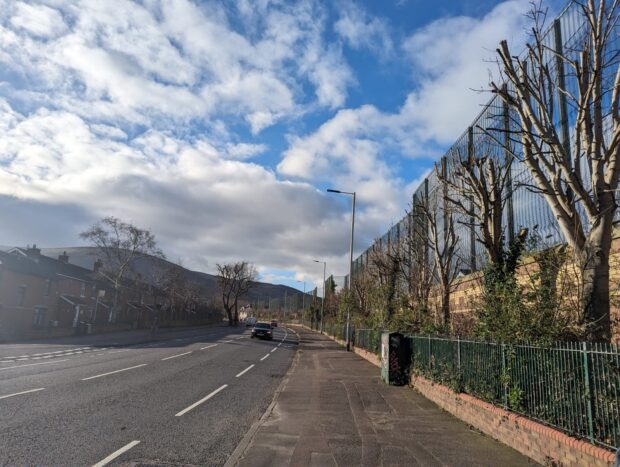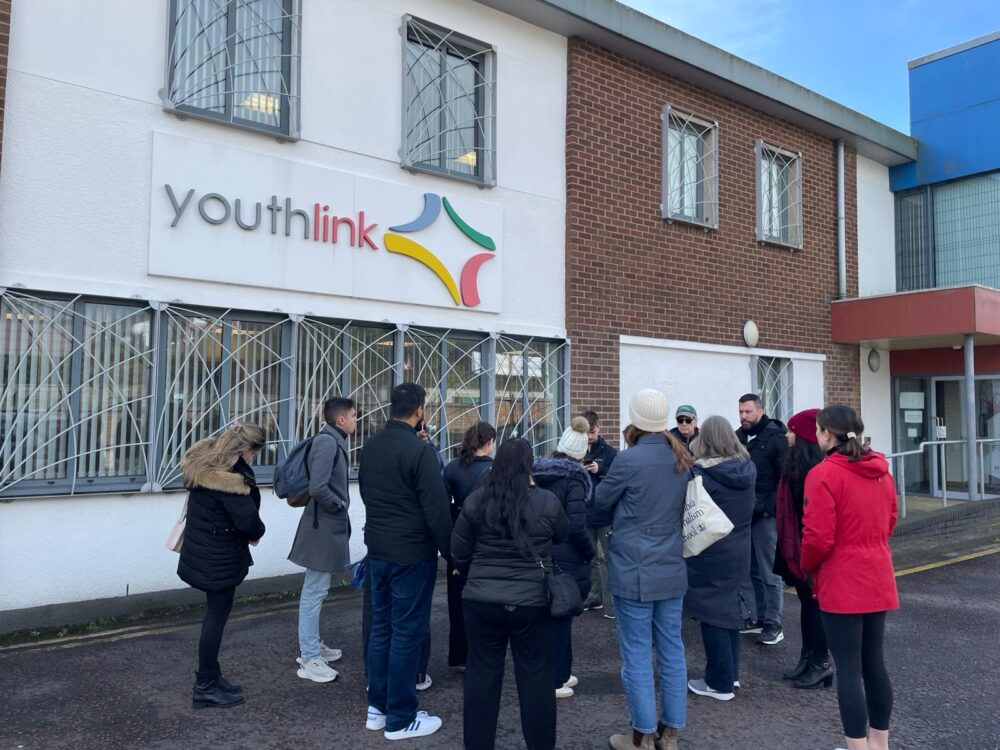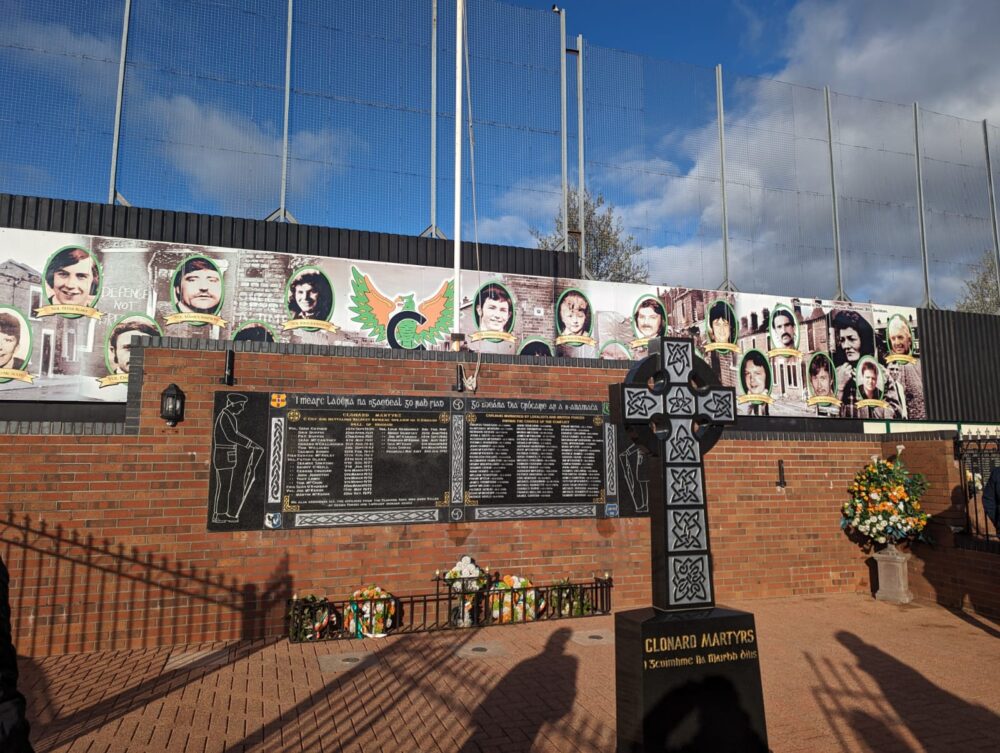BELFAST – After another traditional Irish breakfast buffet of eggs, beans and black pudding, we departed Londonderry for Belfast. This time, the ride was sleepier, as we watched the countryside roll by and reflected on the trip so far.
Like Londonderry, memories of the conflict were alive in Belfast, with the majority Protestant city, the largest in Northern Ireland, draped in Orange Order flags and Irish tricolors alike.
Our bus arrived early at the Europa Hotel, billed as “the most bombed hotel in Europe.” Driver Ben took us on a quick loop through a nearby Protestant neighborhood, Sandy Row, where we were greeted by murals of the Protestant King William of Orange and Queen Elizabeth II. The pubs in the area flew Israeli flags — a stark difference from what we saw in the predominantly Catholic Derry, where sympathies were heavily pro-Palestine.
As we pulled back around to the Europa, our driver cautioned us not to wear any political memorabilia from Derry while walking around Belfast, lest we offend anyone. He said we’d be able to know if we were in a Protestant or Catholic neighborhood by the art and flags.
“[It is] totally crazy, but that’s just the way things are,” he said.
Charity in ‘No Man’s Land’
After dropping off our bags at the Europa, we set out for Youth Link NI, a peace-building youth organization that is unique in that it officially involved both the Catholic and mainline Protestant church leaders, according to our guide, Dr. Barbara McDade, who once chaired the organization.
The charity’s headquarters sit in a “no man’s land” area of West Belfast, near a Protestant enclave of the predominantly Catholic part of the city. “Peace walls,” like we saw in Londonderry, divide Catholic and Protestant neighborhoods. Here though, some stand over 40 feet high. Although the risk of petrol bombs and missiles was less of a threat than during the Troubles, both McDade and our driver insisted that the barriers provided psychological protection to both communities.

The walls were not the only harsh barriers in the neighborhood. McDade led us on a walk that included a stop outside an Orange Order lodge, blocked off by high fences with spikes that curved outward at the top.
She then led us to a walled-off building, complete with additional high metal barriers, watchtowers and cameras. What looked like a military outpost was simply the local police station in Belfast, McDade explained. On the same road, was a gate that McDade said was manually closed each night to prevent Catholics from crossing into the Protestant neighborhood.
Here, McDade shared with us the history of the Royal Ulster Constabulary, the police force during the Troubles that was 97 percent Protestant. The peace process led to several changes in the police force, now called the Police Service of Northern Ireland (PSNI). Affirmative action increased the number of Catholic officers. Still, Catholic PSNI officers often face violence from dissidents of their own communities, McDade said.
“It’s still considered too dangerous for [PSNI officers] to be on foot,” she said of the neighborhood. “The threat, particularly from dissident republicans, is still quite high.”
We saw a memorial to the Springhill Westrock Massacre across the road, commemorating another tragedy at the hands of the British Army.

Youth Link makes a point to employ asylum seekers for its catering services — including the lunch of curried chicken, vegetables and rice we shared. We also sipped tea and coffee while mingling with Youth Link employees.
After lunch, we gathered in a circle with Joe McKeown, a Catholic and the director of Youth Link, around an eclectic pile of flags, clothing and religious regalia from Ireland and around the world. A portrait of Queen Elizabeth sat over a Palestinian flag. A Gaelic football jersey was beside a Ulster Volunteer Force banner — an illegal symbol of the Protestant paramilitary in most contexts. And an American flag was right beside a Confederate flag — something that he said once made a group of visiting Americans so uncomfortable, they wouldn’t enter the room.
“These symbols do have power,” said McKeown. A few people winced as he accidentally stepped on the U.S. flag, proving his point.
McKeown told us that his grandfather was killed by a British soldier’s crossfire. Soon after, papers reported that he was an IRA agent. The trauma that impacted his family in the wake of the tragedy had a significant impact on his life. By his teen years, the sight of a British flag would cause him anxiety, he said.
“My body would go into shivers, I would feel threatened,” he said. Since then, he’s been on a “journey of reconciliation.”
He even tried to meet the soldier who’d killed his grandfather. The soldier had been 18 at the time.
“Kids with guns, trained to kill,” he said.
‘How Do We Remember?’
Next, an interfaith panel joined us to talk about Ireland’s minority faiths. With representation from the island’s Baha’i, Romanian Orthodox, Muslim and Hindu communities, we discussed how the growing diverse groups fit within the Irish story.
“It’s still being written,” said Adrian Cristea, a Romanian Orthodox leader of the Dublin City Interfaith Forum.
After the panel, McKeown brought us to Clonard Monastery, in a neighborhood with deep Catholic roots. On the way there, we passed another gate that separates the neighborhood and locks from 8 p.m. to 6 a.m. Beside a towering “peace wall” we stopped at a memorial to IRA members and civilians killed in the conflict.
“My mother would not be comfortable with me standing here,” McDade, a Protestant, said.

McKeown said there are two difficult questions Belfast residents have to ask themselves: How do we recognize the dead, and how do we also acknowledge that there are victims on the other side of the wall? “How do we remember?”
In the monastery, some students lit a memorial candle for peace, at McKeown’s suggestion.
After a quick dinner on our own, we headed to Belfast Cathedral for a St. Patrick’s Day concert by Anúna, the original musicians behind the ’90s Irish hit Riverdance. Toward the end, the group’s leader, Michael McGlynn, from Dublin, introduced the song Pie Jesu. His version, composed in 1998, commemorates a bombing in Omagh, in the Northern Ireland county of Tyrone. The bombing killed 29 people, months after the Good Friday Agreement was signed on April 10, 1998.
“I don’t particularly want to talk about the context,” he said. “Everyone here has a story about the Troubles.”
Edited by Ann W. Schmidt
